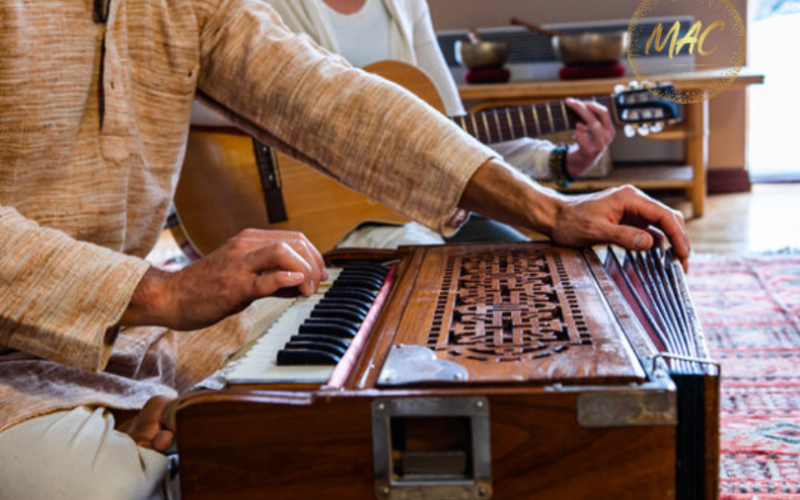The harmonium is one of the most versatile instruments used in Indian classical and devotional music. Known for its rich sound and portability, the harmonium has become an essential part of many Indian music traditions, from classical performances to bhajans and qawwalis. If you are in Redwood City, CA, USA, and looking to learn harmonium, this guide will help you get started.
1. Understanding the Basics of the Harmonium
The harmonium is a keyboard instrument that produces sound through air passing over reeds. It’s known for its expressive capability, where slight variations in breath control and finger pressure can result in distinct tonal qualities. To start, you need to understand the basic structure of the harmonium.
- Keyboard Layout: The harmonium’s keyboard resembles a small piano, but with only white keys. The keys are organized in an octave pattern, and each key corresponds to a specific note in the scale.
- Bellows: The bellows are the heart of the harmonium. They generate airflow to produce sound when air is pushed through the reeds. By pressing the bellows with one hand while playing with the other, you control the volume and tone of the sound.
- Stops and Registers: The stops or registers control the timbre of the harmonium. By engaging or disengaging specific stops, you can alter the sound, making it brighter or softer. This is useful for creating different moods and nuances in the music.
As you begin, focusing on these foundational aspects of the harmonium is essential. It will allow you to understand how the instrument responds to your playing and control the volume and tone more effectively.
2. Learning Basic Ragas
Indian classical music is deeply rooted in ragas, which are musical frameworks based on specific sets of notes and moods. As a beginner, it’s important to start with simple ragas to get familiar with the instrument’s sound and the structure of classical music.
- Raga Yaman: This is one of the most popular evening ragas. It’s often performed to create a meditative and calming atmosphere. Raga Yaman is based on the notes of the major scale and is excellent for beginners to familiarize themselves with harmonium techniques.
- Raga Bhairav: Known for its serious and devotional mood, Raga Bhairav is ideal for practicing basic melodic patterns and perfecting finger movements. It is usually performed early in the morning, and its somber tones provide a good foundation for understanding raga nuances.
- Raga Bilawal: A bright, uplifting raga, Raga Bilawal is perfect for honing your basic playing skills. The raga uses all the natural notes of the scale and has a cheerful, peaceful sound, making it an excellent choice for beginners.
By incorporating Indian classical music lessons into your practice, you will not only learn ragas but also receive structured training to deepen your understanding of rhythm, scale, and improvisation in classical music.
3. Breath Control and Finger Placement
In Indian classical music, the harmonium requires specific breath control and proper finger placement to produce clean, melodious sounds. Here are a few tips to help with both:
- Breath Control: The bellows are controlled by your left hand, which pushes and pulls to create airflow. To maintain smooth and even sound, you need to develop consistent breathing. As you play, ensure that your breath matches the rhythm of the music. This helps create continuous, fluid tones without any interruptions in airflow.
- Finger Placement: Just like playing a piano, proper finger placement is essential for producing accurate notes and scales on the harmonium. Beginners should start by using their index and middle fingers to play the white keys. This allows for greater control and accuracy. Practice playing scales and simple ragas while paying attention to how your fingers move from one note to the next.
- Posture: Make sure to sit comfortably while playing the harmonium, keeping your body relaxed but focused. Your fingers should hover lightly above the keys, and your breath should be steady. This posture will allow you to move quickly between notes without straining your fingers or lungs.
If you want to further refine these skills, consider enrolling in online Hindustani classical music classes, where you can receive personalized guidance and video demonstrations to help improve your technique.
4. Regular Practice and Consistency
The key to mastering the harmonium, like any other instrument, is consistent practice. You must build muscle memory for both your hands and breath. Begin with simple exercises and gradually move to more complex ragas and compositions. Start slow, and as you become comfortable with the basics, you can increase your speed.
Additionally, recording your sessions and listening back can provide helpful insights into your progress. It’s also beneficial to practice with a metronome to maintain a steady rhythm, especially when you begin incorporating tabla or other percussion instruments into your practice.
Conclusion
Learning the harmonium requires patience and practice. It’s not just about playing notes, but about understanding the emotions and expressions that the instrument brings to Indian classical music. Whether you choose in-person classes in Redwood City, CA, USA, or Santa Clara, CA, USA, or opt for Indian music classes near me, consistent training is key.
If you’re interested in learning Indian classical music lessons or learn Hindustani music online, many online platforms offer structured programs that provide detailed tutorials for beginners and experienced learners alike. With dedication and the right guidance, you’ll be playing beautiful ragas and contributing to the rich legacy of Indian classical music.












